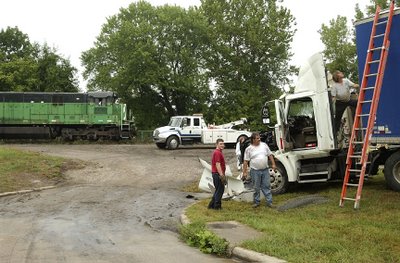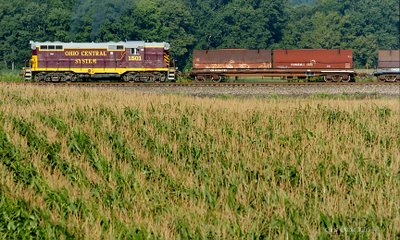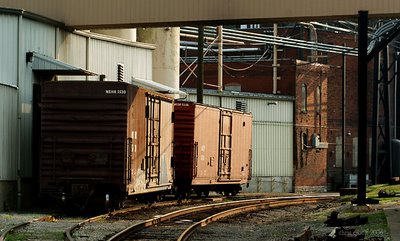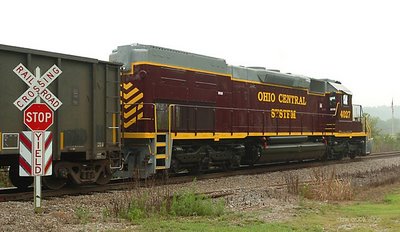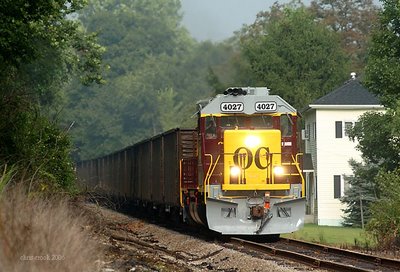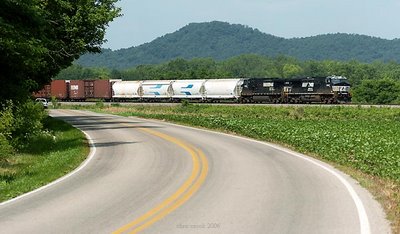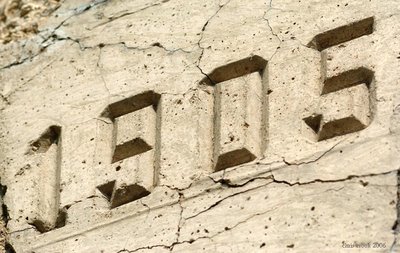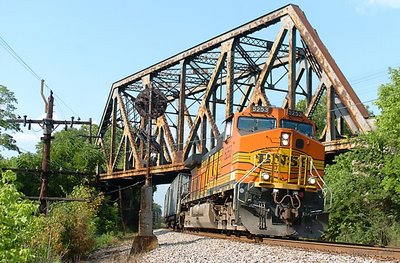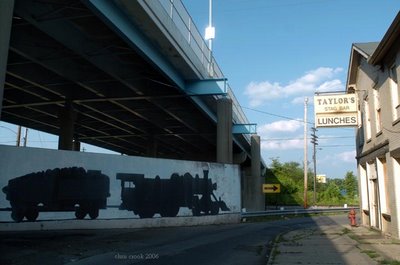May 24-28, 2006
Wednesday after another forgettable day at work I left for West Virginia. The day was forgettable in that it was a fairly typical day, also that I didn't get out when I wanted to get out, or even needed to get out. I didn't get on the road until 2 hours after I expected to. Part of the job, I guess. But the more I need to get out early, the less likely that I will. I can't wait to leave in the middle of an assignment when my daughter is born.
So I headed south, into the lovely golden evening light draping the southern Ohio hills. And construction barrels.
It was the first time I had seen my dad in nearly a year, and we sat on our beds and shot the bull before going to sleep. Took a few minutes to get used to not having a snoring, pregnant wife beside me, and 6 am came even earlier than usual.
We set out into the foggy gloom, down, down, down, into the gorge to Prince. A former Chesapeake and Ohio station sits beside the track. A famous spot, among railfans, a photo of the station's waiting room a source of some recent, unwarranted, controversy among train weirdos. It is a handsome little station.
I don't know what time we got to Prince, but at 7:35 a grain train went west, rumbling along behind two locomotives. The morning fog was still hugging the tops of the hills, hundreds of feet above us, so I shot vertical. Nothing spectacular for me photographically, but it seemed to bode well, as we had both heard the line, while scenic, was sparsely trafficked.

We rolled east to a tiny nowhere called Quinnimont, which used to be a spot of hustle and bustle on the line, but is now looking back at it's glory days, rather than head to a bright future. There was nothing there, and anything railroad related would have required some serious trespassing, it appeared. Crossing the tracks in the middle of nowhere is one thing, hanging outside a yard office is another thing entirely. Sooner or later, we would have gotten the boot, at the very least.
So we headed west, through Prince, on our way to Thurmond, another famous spot. There is no real, viable way to get between said locales, a paved route requiring a long trip over the hills. A short, by mileage, at least, route was a dirt road through the remnants of some other small towns. So we started up a hill down a rutted, bumpy track, that went over a hill the tracks tunneled through below us.
The road is brutal; in retrospect, I should have photographed some of it. We did 10 mph for miles, slowing to ease over rocks in the road, branches knocking the scanner antenna off the car once or twice. Roads that looked even worse disappeared into the wet woods on occasion. The reason for this road's construction had long since disappeared.
I don't know how long it took (but it took a while) we ended up in what appeared to be Thayer. The road got better, and a road that looked mostly passable went off in the direction of the tracks.
So we took it.
We ended up at the tracks after a few switch backs and parked. I had seen something photographed here before. I don't know when or where, but a ramshackle shed with flagpole, complete with tattered flag, sheltered (somewhat) a 1960s era Chevy landshark. The place was cool, and I was happy about the prospects. Some shacks were up the hill from the road, a few occupied houses across the road, and some tilted street signs across the tracks. A pole line followed the track around the corner.

We knew a train was coming from the west, as we had heard something about it on the scanner. So we sat and waited. A maintenance of way truck showed up, and some fellows got out and talked to us. They were trying to figure out where they were supposed to be working, but the village of Thayer it wasn't. They told us a train was coming from the west.
As in most places, we heard the train before we saw it. A rumble filled the valley, and as it got louder, another MOW truck showed up. I was afraid it would block dad's shot, but the guy stopped short before doing so, and the train thundered past, with a long string of loaded coal hoppers.

After the train, we wished the MOW fellows a good day, and headed west, back up the switch back road, and into the woods. The road was in much better shape west of Thayer, good for 30 or so. Still narrow though, and winding.
Soon the track and the road came together, and we saw a train sitting in a siding, a single locomotive on a string of coal hoppers. The windows on modern locomotives are so heavily tinted we couldn't see if anyone was in it, and with no locomotives on the other end, we figured it was a helper for the hills, and sooner or later someone would come along to collect the cars and head west.
As we crossed the tracks on a bridge, we saw another train coming, and had to back up at a high rate of speed, whip the car around, and tear ass down the road to try and get to the tracks before they disappeared into the woods. It wasn't going to happen though, and we watched the train rumble in the great, inaccessible void between Claremont and Thayer.
No matter, we figured, as there would be other trains. So we went to Thurmond, a veritable ghost town, once booming, now reduced to a population of 7. Yes, seven.
Thurmond is a famous place, once a booming coal and lumber town, with all manner of commerce, including a steam engine repair shop. We pulled in, squeezing between the old and vacant buildings and the heavy rail just a few feet away. Signs in the staring windows advertised a glorious, rapidly receding past. Black and white photos testified to the hustle and bustle of the place, including a 10 foot wide panoramic photo from a nearby ridge that showed the entire 1920s Thurmond in all it's glory. It looked like a fantastic place.
What is left is less so. Empty and lonely, our arrival was greeted by a track gang, a site enough to make a railfan's blood run cold. Track gangs on single track mean no trains, and nothing to shoot, especially when they disappear to the inaccessible west, thus vastly reducing themselves as potential targets for pixelated posterity. Dad walked over to a gang doing a weld near the road crossing, and came back frowning. The railroad was replacing rail nearby, and had a maintenance window from 10 am to 5 pm. It would continue next week, as well, from Monday to Thursday.
We talked about heading to the Norfolk Southern's Christianburg Mountain, a few hours away. I didn't want to go there, as it would mean an even longer drive home, and overall less train time. Plus I wanted to see what the mystique of the C&O had to offer. I had high hopes for the weekend.
So we went exploring, looking for an overlook somewhere in the hills above Thurmond. It turns out the fantastic overlook describe in some literature dad had was on private property, heavily posted, and gated, as a final insult. On our way out of the muddy dead end a lady accosted us for driving too fast down her road. We could have a hit a dog or a kid.
We could have, maybe, if the kid had been asleep in the road around a blind curve. In the middle of the night. In the rain.
Oh well. It took an hour to make our way back to Thurmond after our waste of time trip to nowhere. We headed back to Prince, on the same horrible road we had come up on. Crossing the tracks, we saw our coal train had disappeared.
The missed trains to caught trains tally had far too many notches in the missed column at this point, dishearteningly early in the trip.
We moseyed our way south, up and down and around and through the mud of West Virginia until we regained paved road at Prince. Over to Quinnimont, and then away from the tracks, taking a huge detour away over the hills to the north while the tracks curved away southeast. When we turned south again, we followed a branch line down to Meadow Creek. The line was hilly and twisted, and made my mouth water with photographic possibilities. We both hoped a train would head north.
We regained the tracks at Meadow Creek, and looked around a little, and then followed the road to Hinton, as far east/south as we planned on heading. It is the division point, a logical place to stop exploring.
A coal train was sitting at Hinton, clicking and hissing as the metal cars expanded in the sun, and air escaped from leaks in the air hoses. It was parked in front of the Amtrak station, and had been there a while, according to a guy painting the trim at the station. We hoped that this train would head north on the branch at Meadow Creek, as we heard a dispatcher mention the branch earlier.
Even though it was getting late, we still had hours to wait. We headed back up to Meadow Creek, and sat and waited. Dad fell asleep, I read my book. Finally, a train came. Rather anti-climatic, as heavy cloud had covered the sun. We hoped it was a train slowing to head up the branch, instead it was our train from Hinton, and it blew through at 40 or more, blowing coal dust off hoppers parked in the yard at Meadow Creek.

I shot the train curving under a classic C&O signal bridge. Signal systems are one of the trade marks of a railroad, and as more and more disappear into larger systems through merger, they are often one of the few long-lasting relics of earlier railroads. Many railfans can identify a railroad by it's signals, even without a train, or never having visited. Unfortunately, CSX's new paint scheme has built in gloom, it is dark and unimpressive, sucking the light out of a photo on an overcast day.
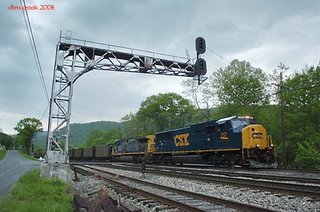
It was 6:40 when the train cleared E. Meadow Creek, our last train at Thayer was at 8:50 am. A long day for not much, including missing two trains.
We expected the flood gates to open, since we were close to a crew change point, trains could be kept there waiting until the track work was done, and then we would be flooded with trains. Not so. We did get another though, an eastbound at West Meadow Creek. It slipped out of the hills in the fading light, as a couple nearby played bluegrass, serenading us with their high, clear voices.
I was starting to feel a little bit of that West Virginia magic.
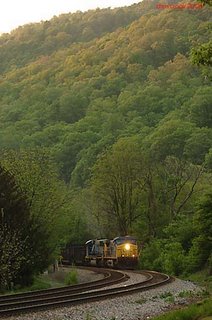
The train was crawling by the time it's end cleared our spot, so we raced east to Sandstone, passing the stopped train on the way. I guess the dispatcher forgot to line the crossovers for a crossover, as the train rolled past our spot down the road a few minutes later. While waiting for a train across the street from the gas station store, I heard a lot of loud talk about us, which I ignored. If they wanted answers to what we were doing, they could come ask us.
The next morning we awoke to clouds and general gloom. We took the long way around to Hawks nest, heading down a long winding road from Minden, expecting to come out at the end of a bridge, instead coming out beside it. But it would do, despite the crappy weather. I am certainly not against rainy weather, I just don't care for blank skies. There was a little ragged cloud around the hills in the distance, which was nice. Better a little sun and a little ragged cloud, but it was not to be.
So we sat. And sat. A lady, her husband, their dog and a boat came along after a while, and the lady tied the dog up on the dock while they put the boat in. The dog regarded me, I regarded the dog, and we went back to ignoring each other. I talked to the lady, they had a cabin on the river, and were going out there to get ready for the summer. The dog would swim when they got there, and then not for the rest of the year.
So I watched the couple put the boat in, and get in and push off. She had told me the dog barked until the engine started, because he liked to help. Sure enough, the old man sat down by the engine, and the dog started to bark. He pulled the cord, it coughed, caught, and the dog stopped barking, and went back the front of the boat, tail held high.
At this point, it was the only action out there.
Around 9 that familiar echoing rumble filled the valley. We couldn't tell which track it was on, because at Hawk's Nest the tracks split, one heading across the river on a nice bridge, the other disappearing into more inaccessible gorge. So unless the train was on track 1, we would see but a fleeting glimpse through the trees.
fortunately, it was on track 1, and crossed the bridge in front of us, disappearing into the damp, gloomy and mysterious gorge.


Back up to the main road, and off we went to find the bottom of the Gorge at Fayette Station.
I can't imagine what was like to have to cross the gorge in a hurry before the bridge. I wouldn't bother, to be honest. A long way down, and long way up on twisting, narrow roads. Now the whole thing is one way, except for mysterious stretches of two way road in between long stretches of one way road. Opposing traffic is minimal.
The tracks are separated by the river at this point, which is part of the mystique of the whole line. But with a one way road system, you have to run between tracks to get a glimpse of the trains. The railroad related shots at the bottom of the gorge here are fairly boring.
So we wound our way down, and were rewarded at the bottom with a foggy view of the massive bridge (much more interesting at the bottom than the top, indeed, when it was foggy you could barely tell you were on the western hemispheres second longest single arch bridge, or whatever it's distinction is) and the old bridge. As well as a ballast cleaner, a cruel looking machine that would also signal no trains, at least on single track. It was unoccupied.
While I was photographing the beast and dad was looking around, we heard that familiar rumble across the river. We scrambled for a place to shoot, and settled with the middle of the bridge. It was a lost shot. Again.
So back up the other side, and over the bridge. Back into the woods, looking for Kinney. After a long, long trip through the woods, we found it wasn't worth the trip. Again.
Back into the rest of the world, we went off to look for Cunard, which appeared to be in Babcock State Park. Which made it seem like it would be an easy spot to find.
After muddling around a bit, we went into ask the park ranger how to get to that spot. She told dad that the tracks were long gone, there were no trains, and we couldn't get there. Despite dad's reasoning that we had seen a train on the same line less than an hour ago, she was unswayed.
So dad went to get the magazine we were following for directions. She told us the road down to Cunard was gated, washed out, and a five mile hike.
So much for Cunard.
Hoping against reason, we followed another road in the park on the off chance that it would take us to the tracks. Instead it lead us to some cabins, and a large group of birders. Scopes, rain gear (cloudy and rainy, again) and binocs gave them away. Dad asked what was out there, and a lady said a
Northern Parula was out and about. I had seen several, but dad, being from Arizona, hadn't seen one yet. So we interrupted her trip to the bathroom to see if we could find one. Of course it disappeared, as did the
Rose-breasted Grosbeak which dad didn't have either. We did see a
Black throated green warbler, which was nice. Then it started to rain. So we left. After I discovered that the lady I was talking to, was fairly well known in the birding world, and I had heard her speak on my local NPR station, as she lives about 60 miles south of me. And her son likes trains, which is good.
Back to the chase, kicked in the ass to get back to work by a train calling a signal about five air miles way, in an impossible spot to get to.
We headed back to Prince, and it's little station. This time, instead of the horrible road, we took a decent road a long way around, part of the route we took to Meadow Creek the previous day. At Rayland a very cool looking former two stall engine house belied a once exciting past.
At Prince we were surprised to find a coal train in the hole, having west. We thought at first it would head up the branch, and then quickly realized it wouldn't do to send a loaded train to a mine.
I went in the station, and chatted with a guy waiting for a cab after Amtrak came through (we missed it, obviously) and the station master. I got them both worked up, saying that if the government funded Amtrak, then maybe he would get more customers. When I went to the bathroom, the two were bitching about the president and the war. When I came back out, they were still at it. I shot a photo of the waiting room and it's sole occupant waiting for his cab.

I went back outside, and told dad about my visit, and the passenger's wait, and then we waited. The signal went yellow, meaning someone was about. We weren't sure, at first, where they were coming from, the branch or the main, when a work train, consisting of one of the older locomotives we saw all weekend, a companion, and some gondolas. We knew a west bound was awaiting a turn to head into the single track tunnel once the other train cleared, but it was still suprising to see a work train hold up a revenue move.

Shortly after the little train cleared the station, and disappeared east toward Quinnimont, we heard an air horn, and then the signal to the west went green. So our west bound was approaching. And a few minutes later, a pair of brand new(ish) locomotives appeared dragging a grain train west.

As is my habit, I watched the grain cars as the train passed, but I was too close to the tracks to make a photo of any interesting cars, so I photographed my dad instead. Nice boiler.

The photo does demonstrate his gear, although some may mistake the tripod's narrow legs for flimsiness. When I tell people my dad videos trains for a living, and that he has a professional camera, it is often met with gentle skepticism, the kind reserved for a stray dog on the approach.
We had an idea that another westbound was approaching, so we decided to move, a bit further west, to where the branch leaves the main line, and the main line ducks under a road bridge and into a tunnel. We parked at a gate, and dad went trackside while I opted to shoot from the bridge. As we waited for a train, I was alarmed to when a track crew showed up. It wasn't CSX, but another smaller company that must have been hired as a contractor. A big flatbed crane truck and a highrailer pulled into my spot, and when the guy in the pickup hirailer got out, I said I expect you want me to move, eh? He didn't, and we talked about where in AZ I was from ( told him Tucson, as dad's car has AZ plates. No need to muddy the situation.) He was looking toward the track when dad poked his head out from behind a bush, and the guy turned to me, slightly alarmed, and asked if I had someone down there. I said yes, my dad. He said ok, unlocked the gate, and the went down to the tracks, as I excused myself, as the train was coming. I shot the train from the bridge, a bridge with no sidewalk. It was probably silly, and as soon as the power cleared, I got off the bridge. Dad came up, and we skedaddled, back up the dirt road to Thurmond.

I was glad that the track crew were ok with us being there, as some would have raised holy hell. I guess they could tell we were harmless, probably because we had cameras and we visible. I don't think terrorists usually spend a lot of time just hanging out. Reading books while waiting for a train.
So back into the woods. We were a long way from anywhere when the scanner crackled and someone mentioned a clear signal, which meant another westbound. We came to a narrow, muddy track heading trackward, so we plunged down it. At a switchback, a huge puddle awaited. I told dad not to go down it, and he told me to throw a rock in it, to see how deep it was. I did, and thought the splash was enough to keep us out of it (I am getting cautious in my old age) but when I got in, we plunged through it. The track was below us, and while I was stoning the puddle, I could hear the train. It passed as we headed down hill, our patient train from Prince.
At the bottom, we were greeted by a guy with a pickup truck, a huge puddle, and a pile of dirt. It appeared CSX didn't want people crossing the tracks there, or at least parking on the right of way. Our new companion was meeting some friends, the same friends that we passed earlier, dragging a boat behind a pickup on the crappy road. They were going to camp and fish all weekend, which meant they would be parking where we were. We were both a bit incredulous about them getting a boat down the even narrower road we were on, but dad moved his car to the top of the hill. I carried our gear across the tracks, and set up, should we be surprised by a train while he was gone.
A signal was visible around the corner, facing west. So I walked west, so see what was out there. The east facing (westbound) signal came into site, and it was green, meaning we would have another westbound. We moved west a little, so see the signals, so we could include them going away. Then we stood around, waiting. I photographed one of the most hideous bugs I ever seen, and we watched the fishing expedition cross the tracks. Lots of coolers, that appeared to be very heavy. Beer, presumably. And then the boat. It took all of 15 seconds. And of course we expected the train to come during that tiny window, and smash the boat and ruin our afternoon, the fishermen's afternoon, and trapping us with a train between us and the car.
And of course it didn't. But the signal went out, and I envisioned being ousted by a signal maintainer during the 5 or so seconds it was out when it came back on, this time red. So we had an east bound train. We moved west, to shoot the train framed by the signals And a short time later, the familiar rumbled filled the valley. Another loaded coal train appeared out of the mist and thundered past. I can only imagine the thunder in steam days.

So we trudged back to the truck, leaving behind what was once McKendree. As we marched up the muddy track back to where dad parked the car (we were alarmed to note the headlights were on) I paused to photograph the only sign of the past I saw; (besides some broken crockery) some mossy stairs, leading into the lush West Virginia jungle. Someone once lived here, and on our way out I pondered the temporary nature of company towns, of capital and sweat equity left behind when times get tough.

Back our muddy track, the truck's automatic lights still on, because of the tree gloom, through Thayer, to Claremont. We stopped, examined the situation, and found it to our liking. We crossed the tracks on a well worn path, and waited. The sun came out, and lit the tops of the hills as it disappeared for the night. A lovely sunset played out behind us.
As the light softened, warmed and slowly darkened, I walked down the side of the tracks to check the signals. Amtrak was due sometime in the evening, although thanks to twisting nature of our route, we were unsure exactly which way it would be coming from, until after some directional negotiations on our part, we realized it would be coming under the nice signal gantry to our east.
The signal was green. Someone was coming, although when was still up in the air. It could be hours, or minutes.
As the sun receded, the fog began to roll in, and we decided to stay until the light was gone, and then decided to stay until the train came. As the light left, and the evening blued, I did some test exposures.

I think we saw the light of the approaching train the same time as we heard it, and as the train approached I made my exposure.

The train roared past us, faster than most, the long wheelbase coaches squealing around the curve, the headlight lighting the trees as the lights bringing up the rear glowed like little red eyes until they disappeared behind the trees. We both drew a breath and agreed it was pretty spectacular.
On the way out, I stopped and made one last frame.

definitely worth missing out on a decent dinner. (because everywhere worth eating was closed by the time we got back to Beckley)
Back out the next morning, again in the fog. We found our way to Sewell, when the tracks rejoined after their time apart across the river. We knew we wanted to be down by the river, but getting there wasn't immediately apparent. After making our way down to river level, our first obstacle was a stream. Too wide and rocky to jump, and not quite enough rocks above the water level to dash across, especially with heavy gear. We tried a number of routes, including one that left me with one wet foot until dad found a way across, and we continued our treacherous path along the river. No path, just rocks. Finally, we found a spot, and the waiting commenced. The sun had not yet come over the hill when we heard the now familiar echoing rumble over the roar of the rapids. We wondered about rafters, but none showed. The sound bounced around the canyon, until we weren't 100 percent sure which track the train was one, until it abruptly shifted to the left, and a train appeared on the bridge, crawling across under a permanent 10 mph slow order.

The sun was making it's way over the ridge, so we waited for another train. Unfortunately, it hadn't made it's way around enough to be quite right, but we did see some rafters.
We made our way back to land, over the treacherous rocks, taking care not to damage ourselves or our gear, and then up to the track level, where we waited an eternity for the daily freight train to come. By noon, it was time to cut our losses, and we headed back to the truck, after shooting the remains of the west-side sub. The tie plates were dated 1936.

When we got to the car, we heard a train call the signals, a westbound, so we searched for river access. We ended up shooting from a little boat ramp as a train passed on the other side of the river, in crappy light, with rafters in the foreground. There was a big group of butterflies there as well, something we had seen on every damp spot in the sun the whole trip. There were pipevine swallowtails (yellowish blue) spicebush swallowtails (the sharp one in the center of the frame) and the eastern tiger swallowtail. And some little tinys I couldn't get a photo of.

From the random riverside view we made our way back through a throng of slack-jawed teenage rafters that moved like a very slow herd of cattle out of the way of our truck as we passed. I thought about mooing as we passed, but thought better of it.
To Thurmond, probably 5 miles away as the track curls, but a much longer trip by rubber wheel. We got there, set up, and waited. As is normally the course. I walked across the bridge to photograph a Mopac boxcar sitting at the shortline across the river. On the way I photographed some friendly graffiti and some hobo marks.


The hobo, generally known as the Colossus of Roads is pretty well known, having put his chalk mark on thousands of freight cars. Hobo marks are generally fairly discreet, seen near ladders on boxcars mostly, although I saw and photographed a number on coal hoppers.
I rejoined dad on the railroad side of the river, and we waited. It was getting warmer, and sunnier as the day moved on, it had turned into a nice day. Of course the light was high overhead, and in general the light was pretty mediocre at best, but it was still nice to have some sun. I kept my sweatshirt on though, as I don't like sunscreen and like sunburns even less. I probably looked fairly disreputable, having neither shaved nor showered in a few days.
I can't remember if the scanner tipped us off to an eastbound coal train, or the familiar rumble, but either way, we ended up shooting a pair of eastbound coal trains. I did the same thing with both, a fairly familiar shot of a train curving past the Thurmond landmarks; the coaling tower, the downtown buildings and the signal bridge. I left in a lot of the big green wall, and if you pay attention to the railroad video/dvd market, you may see this photo (or one similar) in the not too distant future.

Having somewhat exhausted the current light possibilities of Thurmond, we headed south again, stopping at Claremont, as there weren't many other nearby places to stop. If traffic is rolling, I suspect it is easy to get stuck in one place on this line.
Standing around at Claremont, when a train appeared out of the east, and then curved into the siding. I messed up the shot. Oops.

The train goes clunking around the curve, and I snap away at the grain hoppers as they roll past. The end passes, and is it recedes away in the distance, another train pokes it's nose around the curve. A-ha! A meet! and the first of the trip. A new GM rolls past on a train of loaded coal hoppers, and then it too disappeared into the woods.

We were standing around mulling our possibilities when the signal went yellow, meaning a train was following other other east. A few minutes later it went green, and a bright yellow nose eased around the curve and a pair of Union Pacific locos rolled past with a molten sulfur train. When the power was beside me, the engineer saw the green signal and notched it out, and the train roared off.

Dad and I headed west, up through Thurmond and out to the highway at Glenn Jean, where we went north to cross the gorge and try and find an overlook. We first looked at Nuttal cemetery overlook, but found our view blocked by a perfectly placed tree. In theory, one could have jumped down a minor cliff to see around it, but one doesn't tend to do that so much with $30,000 worth of pro video gear. Especially since a way back up was not assured. So back out through the cemetery, following directions that were clearly not written from the field, but from home days or weeks afterwards. From memory, apparently, since they left out significant parts of the directions, like, turn right at the post office.
So after a rather muddled approach, we finally found Nuttal Station overlook. There were a lot of cars lining the side of the dirt road, apparently rock climbers, although we didn't see any, or hear any tortured screams and dull thuds. Into the woods we went, and found a decent view of the track. Or one of them, as the tracks were split at this point. The westbound track was lit, more or less, and the eastbound track was completely shadowed by the gorge. We stood around, and searched for a peeping bird in the bush. The cliff was fascinating, as I couldn't tell how high it was, even by lying down and looking over the edge. Dad stayed near more solid ground.
The rumble appeared, and a westbound empties passed below us. The light was awkward, not quite right, not quite glinty, if that was even possible without horrendous lens flare.

Back through the woods to the truck, and then over hill and dale through the softening light to Hawk's Nest State Park, and it's pair of overlooks. The first was ok, the second an immortal spot. We walked down the stairs, and while we were walking back to the car we head the rumble, so we had to run.
unfortunately, it was an eastbound, and the sun had covered the eastbound side track, and was rapidly eating away at the westbound track as well. So we shot the train as it curved through the canyon below us, serenaded by the redneck yap of some civil war reenactors, who kept jabbering about how they didn't like Yankees. I don't know if it was for our benefit or not. I guess I could have asked them why they liked to reenact the losing side, but it was a long way down.

After our train we rolled west and down, until we found the tracks at Kanahwa Falls. No sign of any trains, by signal or scanner, for the rest of the evening.
Vaguely sunny Sunday morning when we headed back to Hawk's Nest with the intent of finding our way across the river. We didn't have look that hard to find our way across the river, we took the well maintained walkway on the side of the railroad bridge. It probably would have been frowned upon by CSX, had we come across any one who gave a damn.
The sun was fighting it's way through the clouds when we got our first train, an eastbound. The sun came out halfway through the train, then packed it in for the rest of the morning. Two more trains went east, including Amtrak, and then it started to rain. Dad and I stood under a tree and talked while we waited for a westbound. Finally we got a coal train crawling across the gleaming bridge and trickling past us. It was time to leave, for me to head home, and dad to find a new location. He would stay another week, finishing up shooting for his DVD on the gorge. On our way back across the bridge, another eastbound snuck past us. Too many trains in one spot. Stuck.


While sitting across the river from the boat ramp and parking lot, I noticed a large crowed of people standing around the ramp. I figured a boat group was going to head out on one of the pontoon boats tied up on the shore, and I didn't pay much attention. After the last train, as we made our way past, I saw that it was a baptismal in the New River.
Damn. It would have been a fantastic shot, a baptismal with a coal train crossing the river in the background. I can see it in my head still, two weeks later, and it sums up the trip for me, a series of almosts and not quites, not enough trains and light that teased and disappeared. Generally the photos were successful, and it was a good time, it was great to hang out with my dad again and watch trains, as it had been far too long. I can feel the gorge still, close, but too far for a one day trip. The shots are there, with luck and patience, the spirit of the gorge hiding silently in the shadows.
